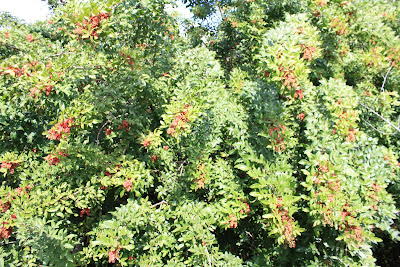Brazilian pepper (Schinus terebinthifolius) is an extremely problematic non-native invasive shrub or tree that is invading natural areas to the point that it disrupts the native communities. This plant is native to Argentina, Paraguay, and Brazil. It was introduced into the United States as an ornamental back in the 1840s. It can invade numerous habitat types including pinelands, hardwood hammocks, cypress, and even mangrove forests. It tends to form dense thickets; these thickets don't allow much light to penetrate so numerous natives can't grow or are displaced.
This plant has been seen flowering throughout the year in Florida, but the most intense period of flowering is in the fall (between September and November). It is readily spread by wildlife that forage on its bright red berries. It is very resilient and can re-sprout readily from the trunk, making it ever harder to eradicate. A relative of poison ivy, it produces chemicals that can irritate people's skin and respiratory systems.


No comments:
Post a Comment